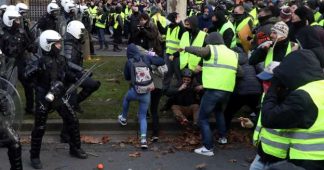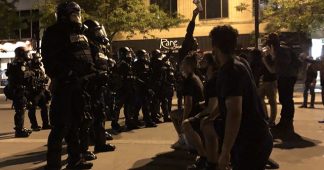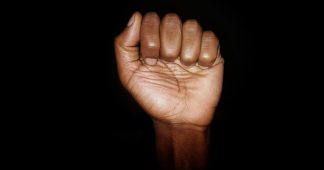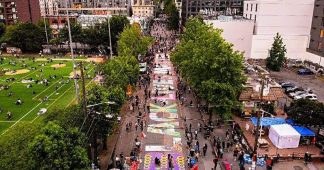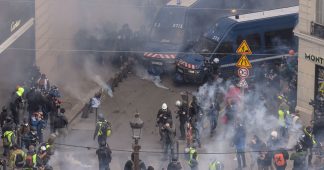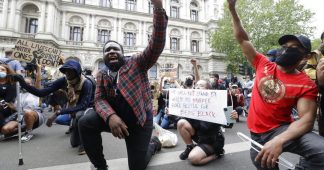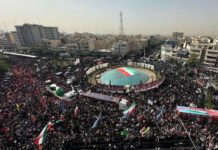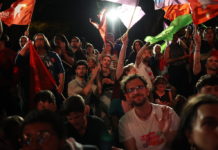Hundreds were arrested on single days during Trump’s inauguration and this summer’s uprising — and just 52 were at the Capitol.
By Natasha Lennard
Four years ago, I joined hundreds of protesters in Washington, D.C., to march in confrontational and furious opposition to a newly elected president. This was not the vast, largely placid Women’s March, which led to zero arrests, but the explicitly anti-fascist black bloc protesting on President Donald Trump’s Inauguration Day, January 20. In the context of the fast-moving march, as the crowd snaked through northwest D.C, a number of chain stores and bank windows were smashed. Tight flanks of militarized riot police moved in swiftly with batons and pepper spray. Within an hour of the march’s first steps, almost half of the participants — over 200 people — were trapped on a freezing corner behind heavy police lines. These J20 protesters would face bogus riot charges, which did not stand up in court but carried potential decades in prison. This is what state repression looks like.
In early June last year, as powerful anti-racist protests swept through the country in the wake of George Floyd’s killing, police in D.C. arrested 289 people in just one night — and 736 people over a week. Riot cops and National Guardsmen used lashings of tear gas and rubber bullets to clear protesters from a plaza where Trump had planned a cynical photo op in front of St John’s Church. This, too, exemplified repression.
Meanwhile, four hours after armed Trumpians besieged the home of the U.S. government, only 14 arrests had been made by the Capitol Hill police. Footage showed officers assisting the right-wing rioters as they left the building. Later in the night, 30 more arrests were made for violations of a 6 p.m. curfew imposed by the city. Publicized official tallies recorded 52 arrests in total.
This is what it looks like when the police have no interest in repressing a movement. Given the essentially racist nature of U.S. policing, no one should be surprised that even extremely militant anti-authoritarian activity perpetrated for a white supremacist cause is not deemed a target of U.S. law enforcement’s vast and violent repressive capacities.
After hundreds of Trump supporters stormed the U.S. Capitol on Wednesday to disrupt the certification of Joe Biden’s victory, social media was flooded with commentary on the relatively lax, if not outright enabling, response from D.C. police. The far-right mob had descended on D.C. in response to Trump’s call for a “wild” protest. His white supremacist base had been explicit online about plans to converge as an armed and insurrectionary force. As I noted just the day prior, violence was all but inevitable. Yet the far-right protesters were met with a thin and scattered showing of police.
“Few of the cops are in riot gear, they don’t have a line completely set up, the barricades don’t cover the entirety of the steps,” Legba Carrefour, a D.C.-based longtime anti-fascist organizer — and a personal friend — posted on Facebook while observing the events prior to when the Capitol was breached
One woman, a Trump fanatic and conspiracy theorist, was shot by a police officer inside the Capitol yesterday, according to official releases, and three other people died from “medical emergencies.” Numerous commentators have rightly stressed that had any other demographic of protesters attempted to storm the Capitol in a similar manner, they would have been slaughtered en masse. The brutal repression faced by Black protesters last summer makes this clear enough, but even everyday occurrences around the Capitol have proved deadly: In 2013, Miriam Carey, a 34-year-old Black woman was shot and killed after merely making a U-turn in her car at a checkpoint on Capitol Hill grounds.
The law enforcement response to Wednesday’s white riot was representative of the bent of U.S. policing exacerbated and emboldened under Trump.
It would be false to claim that the majority of Capitol Police officers, as individuals, invited the armed and chaotic crowds to storm the building. The point is more structural: The fact that police presence was so small for an event so laden with violent potential tells us everything we need to know about the ideological commitments of the institution of U.S. policing. A Capitol Police statement said that its forces had been stretched too thin, but even this speaks volumes about the lack of preparedness. On Inauguration Day 2017, for instance, police committed a full battalion of riot cops just to the 500 protesters marching with J20.
As a point of statistical fact — which even federal law enforcement registers — far-right racists are by far the deadliest extremist threat in this country. Yet the apparatus of “law and order” has made clear through its enforcement, again and again, that it does not perceive these groups as a threat.
Insofar as the raison d’être of policing, like the raison d’état of the United States, is the maintenance and protection of whiteness and property, even the most fanatical right-wing extremists do not pose an existential threat to the state, even when storming statehouses.
Many rightfully outraged comments on the double standard evinced by the police on Wednesday emphasized the mistreatment of peaceful Black protesters compared to the armed, destructive Trump supporters. But what the police have long, and once again, made clear is that whether a movement falls under the state’s repressive sights has little to do with the activists’ tactics.
Unarmed Black people are consistently treated as an a priori threat. An armed cop can shoot an unarmed Black child and call it “self-defense,” and the entire judicial system will nod in agreement. Yet armed white supremacists gathering in their thousands with the stated aim of attacking government buildings and officials are met with scant police resistance.
The distinction is key. When liberals decry more militant leftists and anti-fascists for a willingness to damage property — as in the J20 case and during last summer’s uprisings — they claim that it invites heavy policing of social and racial justice activism. The law enforcement treatment of far-right rioters, though, shows how little tactics have to do with whether the state commits to crushing a movement. In turn, it should be the violent white supremacist motivations of the Trumpian diehards that we oppose, not the breaking of Capitol building glass
The point is that we should pay attention when U.S. policing makes its priorities unambiguous: when it manifests as an occupying military force and when it does not. (Though Black liberation fighters last summer made clear that overwhelming the police, even when faced with far greater repression, is indeed still possible).
There’s little doubt that there will be further arrests of neo-Nazis and assorted conspiracy theorists caught on film rampaging through Capitol Hill; the FBI has stated it seeks, post hoc, to identify the instigators. It could also be argued, at a stretch, that given the failed prosecution of the J20 defendants, D.C. police have shifted tactics away from mass arrests — but the response to the summer’s Black Lives Matter uprisings made clear that a willingness persists to grab protesters in great numbers on a given occasion.
Participants in Wednesday’s insurrection may well face grave criminal punishments; the government, if not the current president, is invested in the performance of such justice. There will be arrests, charges, and trials — lest the hypocrisy cause more public backlash than it’s worth. The difference here lies in the lack of willingness or desire on the part of law enforcement to repress far-right, white supremacist violence. That is the nature of state repression, because that is the nature of the United States
Published at theintercept.com
